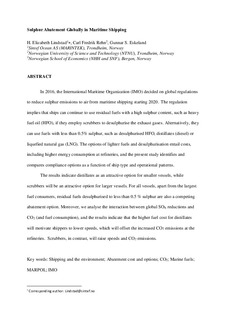| dc.contributor.author | Lindstad, Elizabeth | |
| dc.contributor.author | Rehn, Carl Fredrik | |
| dc.contributor.author | Eskeland, Gunnar | |
| dc.date.accessioned | 2017-11-06T13:12:59Z | |
| dc.date.available | 2017-11-06T13:12:59Z | |
| dc.date.created | 2017-11-01T18:40:10Z | |
| dc.date.issued | 2017 | |
| dc.identifier.citation | Transportation Research Part D: Transport and Environment. 2017, 57 303-313. | nb_NO |
| dc.identifier.issn | 1361-9209 | |
| dc.identifier.uri | http://hdl.handle.net/11250/2464282 | |
| dc.description.abstract | In 2016, the International Maritime Organization (IMO) decided on global regulations to reduce sulphur emissions to air from maritime shipping starting 2020. The regulation implies that ships can continue to use residual fuels with a high sulphur content, such as heavy fuel oil (HFO), if they employ scrubbers to desulphurise the exhaust gases. Alternatively, they can use fuels with less than 0.5% sulphur, such as desulphurised HFO, distillates (diesel) or liquefied natural gas (LNG). The options of lighter fuels and desulphurisation entail costs, including higher energy consumption at refineries, and the present study identifies and compares compliance options as a function of ship type and operational patterns.
The results indicate distillates as an attractive option for smaller vessels, while scrubbers will be an attractive option for larger vessels. For all vessels, apart from the largest fuel consumers, residual fuels desulphurised to less than 0.5% sulphur are also a competing abatement option. Moreover, we analyse the interaction between global SOX reductions and CO2 (and fuel consumption), and the results indicate that the higher fuel cost for distillates will motivate shippers to lower speeds, which will offset the increased CO2 emissions at the refineries. Scrubbers, in contrast, will raise speeds and CO2 emissions. | nb_NO |
| dc.language.iso | eng | nb_NO |
| dc.publisher | Elsevier | nb_NO |
| dc.rights | Attribution-NonCommercial-NoDerivatives 4.0 Internasjonal | * |
| dc.rights.uri | http://creativecommons.org/licenses/by-nc-nd/4.0/deed.no | * |
| dc.title | Sulphur Abatement Globally in Maritime Shipping | nb_NO |
| dc.type | Journal article | nb_NO |
| dc.type | Peer reviewed | nb_NO |
| dc.description.version | acceptedVersion | nb_NO |
| dc.source.pagenumber | 303-313 | nb_NO |
| dc.source.volume | 57 | nb_NO |
| dc.source.journal | Transportation Research Part D: Transport and Environment | nb_NO |
| dc.identifier.doi | 10.1016/j.trd.2017.09.028 | |
| dc.identifier.cristin | 1510010 | |
| dc.description.localcode | This is the authors' accepted and refereed manuscript to the article. Locked until 10 October 2019 due to copyright restrictions. | nb_NO |
| cristin.unitcode | 194,64,20,0 | |
| cristin.unitname | Institutt for marin teknikk | |
| cristin.ispublished | true | |
| cristin.fulltext | postprint | |
| cristin.qualitycode | 2 | |

